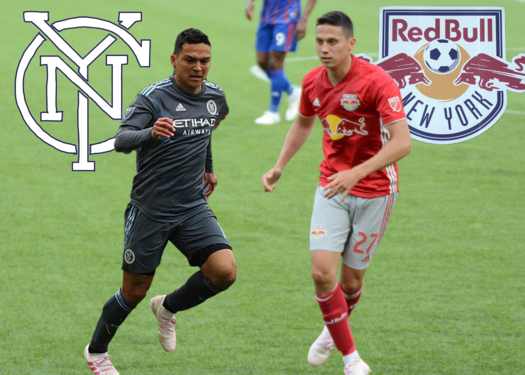New York’s soccer scene: a clash of corporate ownership
Delving into the dynamics that form the heated rivalry between New York City FC and New York Red Bulls.

Tony Rocha is a midfielder with the New York City Football Club and Sean Davis is a midfielder with the New York Red Bulls. While seemingly different, there are many common parallels between the rivaling teams. (Images via Wikimedia Commons, Staff Illustration by Ryan Kawahara)
October 6, 2021
Just over eight years since the rivalry between the New York Red Bulls and New York City FC began, it’s becoming more and more clear that one side of New York is winning on the pitch as well as winning more public attention. The New York Red Bulls are Major League Soccer originals, joining the league during its inaugural season in 1996 (under the name New York/New Jersey MetroStars until Red Bull GmbH bought the club in 2006), but NYCFC’s founding in 2013 and first season in 2015 split New York soccer fandom into red and blue halves. Some fans of the blue side never supported the MetroStars/Red Bulls, while others abandoned the red side for a blue beginning.
These teams are undoubtedly difficult to support for many reasons. The Red Bulls/MetroStars (trophyless for 25 seasons and counting) play in New Jersey, first at Giants Stadium in East Rutherford, New Jersey, until 2010, before moving to Red Bull Arena in Harrison, New Jersey. NYCFC does play within the five boroughs, but not in their own soccer stadium. The New York team is majority owned by City Football Group (owners of Premier League giants Manchester City as well as Yankee Global Enterprises) plays in Yankee Stadium — yes, a baseball stadium. Red Bulls fans taunt NYCFC fans about this fact, while NYCFC fans taunt Red Bulls fans that their team plays in New Jersey.
However, that’s slowly becoming a moot point, as after the conclusion of the 2021 MLS season, NYCFC will have played close to a majority of their home games at Red Bull Arena. Scheduling conflicts with the New York Yankees has limited NYCFC’s ability to play at Yankee Stadium. Playing in their biggest rival’s venue for eight home games a season, NYCFC is becoming the team they swore not to be: a New York team playing in New Jersey.
Regardless of stadium location and type, the blue side of New York has been playing better soccer as of late, while the red side of New York is currently on a three-season decline and in jeopardy of missing the playoffs for the first time since 2009. NYCFC has finished above the Red Bulls in the Eastern Conference standings in three of the past four seasons. Even though the Red Bulls hold the derby record against NYCFC, with 11 wins in the series as opposed to NYCFC’s six, NYCFC has recently been playing with a more attractive strategy and flashier players. In 2021, NYCFC ranks 10th in wage bills with $12.99 million spent on their roster, and the Red Bulls rank 21st at $10.17 million spent. NYCFC is currently using all of their Designated Player roster spots (up to three players per roster who can be paid more than the league’s salary cap), while the Red Bulls are currently only using one slot.
NYCFC boasts more veterans on their roster with an average age of 25.4, whereas the Red Bulls are focusing on younger up-and-coming talent with an average age of 23.2. And under head coach Gerhard Struber, appointed in October 2020, the Red Bulls team building philosophy seems set to continue emphasizing both youth player acquisition and development. For Red Bulls fans, the team is simply becoming less and less fun to watch, as not much proven talent is making its way into the squad. With the recent exports of 2015-18 Red Bulls head coach Jesse Marsch and teenage players Tyler Adams and Caden Clark to RB Leipzig in the German Bundesliga (one of many Red Bull sister clubs), fans accuse the team of being a feeder team to Europe.
NYCFC is moving past its initial strategy of chasing name recognition and star-power. Star-studded rosters of the past featured European greats such as David Villa, Frank Lampard and Andrea Pirlo. Similarly to the Red Bulls, they are pursuing academy development, but they boast a veteran core. Players 29 and older like Anton Tinnerholm (30), Maxime Chanot (31), Sean Johnson (32), and Maxi Moralez (34) complement their younger, more unproven talent. And their younger teammates are beginning to prove themselves in impressive ways with 23-year-old Valentin Castellanos notching 13 goals on the season, tied for third place in the Golden Boot race.
For the Red Bulls, many of their veteran presences were developed from within with current captain Sean Davis being the club’s first homegrown captain. When a steep majority of your talent is produced in-house, you are putting all your eggs in one basket — most players are raised in the Red Bull system of suffocatingly high press. And as NYCFC fans love to bring up, the Red Bulls sit well below the playoff line in ninth place in the Eastern Conference while NYCFC is placed sixth in the table. Just over a month remains in the 2021 MLS regular season.
Despite their downward trend, the Red Bulls remain committed to following the broader Red Bull system, which is not confined to Red Bull New York but consistent among all of the other Red Bull sister clubs: Red Bull Bragantino (Brazil), Red Bull Salzburg (Austria) and RB Leipzig (Germany), as well as lower-league affiliates at New York, Bragantino and Salzburg. This system fostered the aforementioned moves of Jesse Marsch, Tyler Adams and Caden Clark to Europe as well as acquisitions in New York from other sister clubs, namely Red Bull Salzburg.
High-pressing and high intensity play are characteristic of the Red Bull system, which fans have derided as “energy drink soccer.” It is a style of play in Major League Soccer that other teams have been able to analyze and break down more successfully over the years. In New York, that multi-season decline is partially due to this consistent style of play that produces inconsistent results. Nonetheless, it’s a globally recognizable system that allows Red Bull Global to integrate teams across three continents. Recent reports from the New York Red Bulls blog, Once a Metro, indicate that the Global Sporting Position may have a new face soon, representing the continued trust and interest in this cohesive, multinational style of play.
But NYCFC isn’t immune to corporate ties either. City Football Group, with a majority ownership by Abu Dhabi United Group, boasts even more sister clubs than Red Bull Football with nine around the world (most notably Manchester City of the English Premier League). Does this corporate ownership of teams delegitimize the sport, turning it into a battle of wealthy corporations that outpace smaller ownership? Do fans of both New York clubs suffer from shipping off their talent to their European sister clubs? Kristian Dyer, writing for Fansided, argues that RBNY shouldn’t be viewed as a feeder team.
“If the New York Red Bulls didn’t have this system and pathway then Caden Clark likely isn’t coming to the club at all,” Dyer wrote. “The sales pitch to a talented young player like Adams, who moved to RB Leipzig two years ago, was made easier in selling the Homegrown a path to the Bundesliga.”
Dyer also commented on the other side of New York and how “New York City FC has not been able to bleed in their Homegrown talent into their City Football Group subsidiaries,” at least not as successfully as RBNY have accomplished. Yet, Dyer is pragmatic about the role these New York clubs play. They exist as small parts in big global nextworks. As such, you can either enjoy the talent knowing it’ll eventually be exported, or never experience that talent to begin with. That constant turnover of promising players moving to Europe has been frustrating for Red Bulls fans.
Even in a bleak season, Red Bulls fans, whose team has been in the shadow of NYCFC in the standings for three seasons now, have something to cheer about. Two weeks ago, the Red Bulls played NYCFC to a late, dramatic 1-1 draw at home before winning 1-0 at Yankee Stadium three days later. This represented their first win in the Bronx since their resounding 7-0 beatdown of the blue team in 2016, dubbed “The Red Wedding” by fans. One more Hudson River Derby matchup is scheduled for Oct. 17 at Red Bull Arena to decide which team takes the season series.
MLS writer Tom Bogert commented in August about NYCFC’s recent dominance in MLS play and the red/blue rivalry in general.
“While the rosters, and ways of building them, have changed for both clubs, the rivalry’s still one of the most anticipated encounters on both teams’ [schedules],” Bogert wrote. “And if that game five years ago tells us anything … it’s that anything can happen when these two rivals collide.”
With the combination of factors such as overall roster strength, position in the standings, recent results in the derby and overall fan satisfaction, the answer to the pervading question “What color is New York?” is somewhere in the middle. Combine these factors and you don’t get just red or blue: fans will have to accept the fact that New York’s soccer has been (and might always be) some shade of purple.
Contact Luca Richman at [email protected]
























































































































































